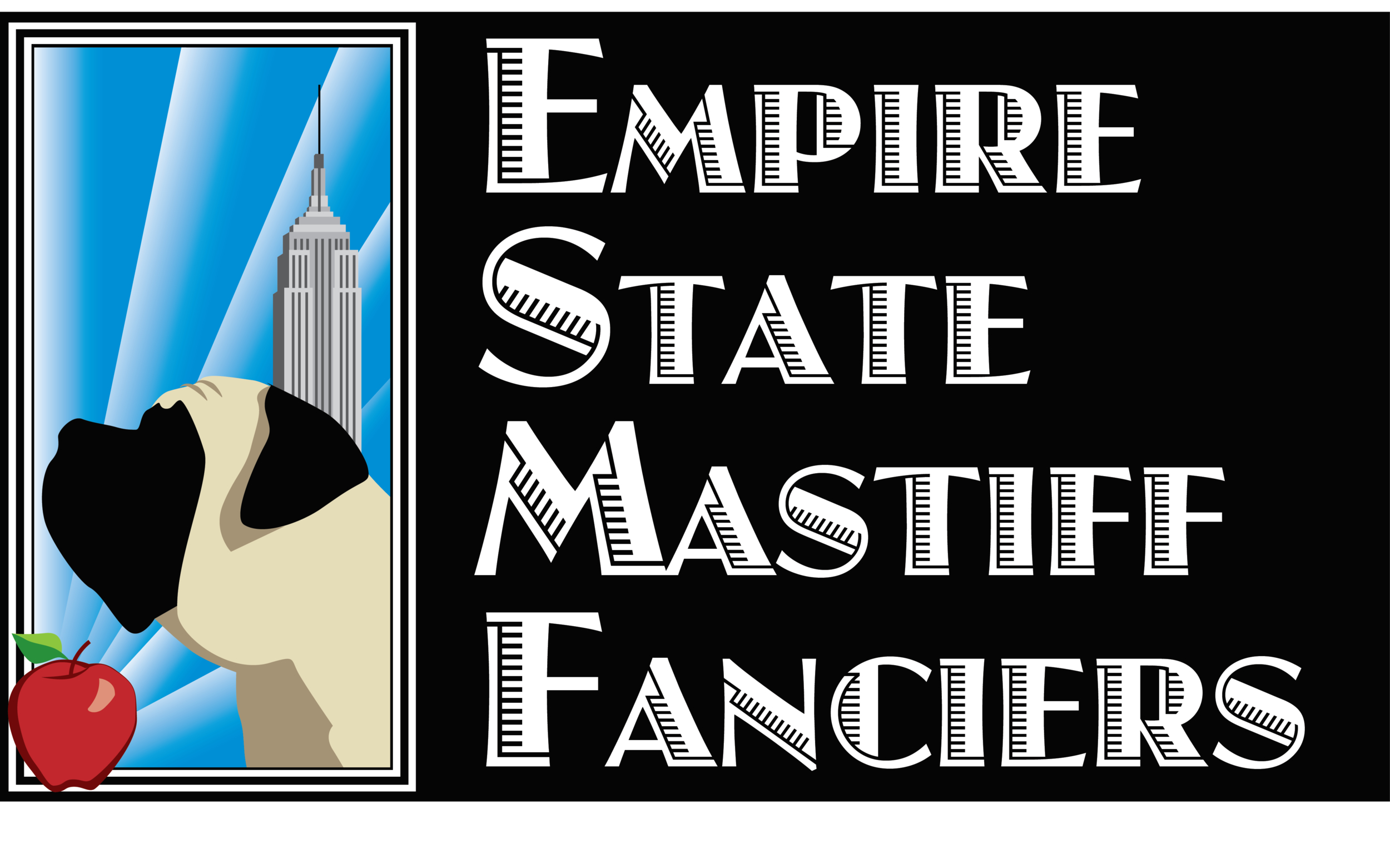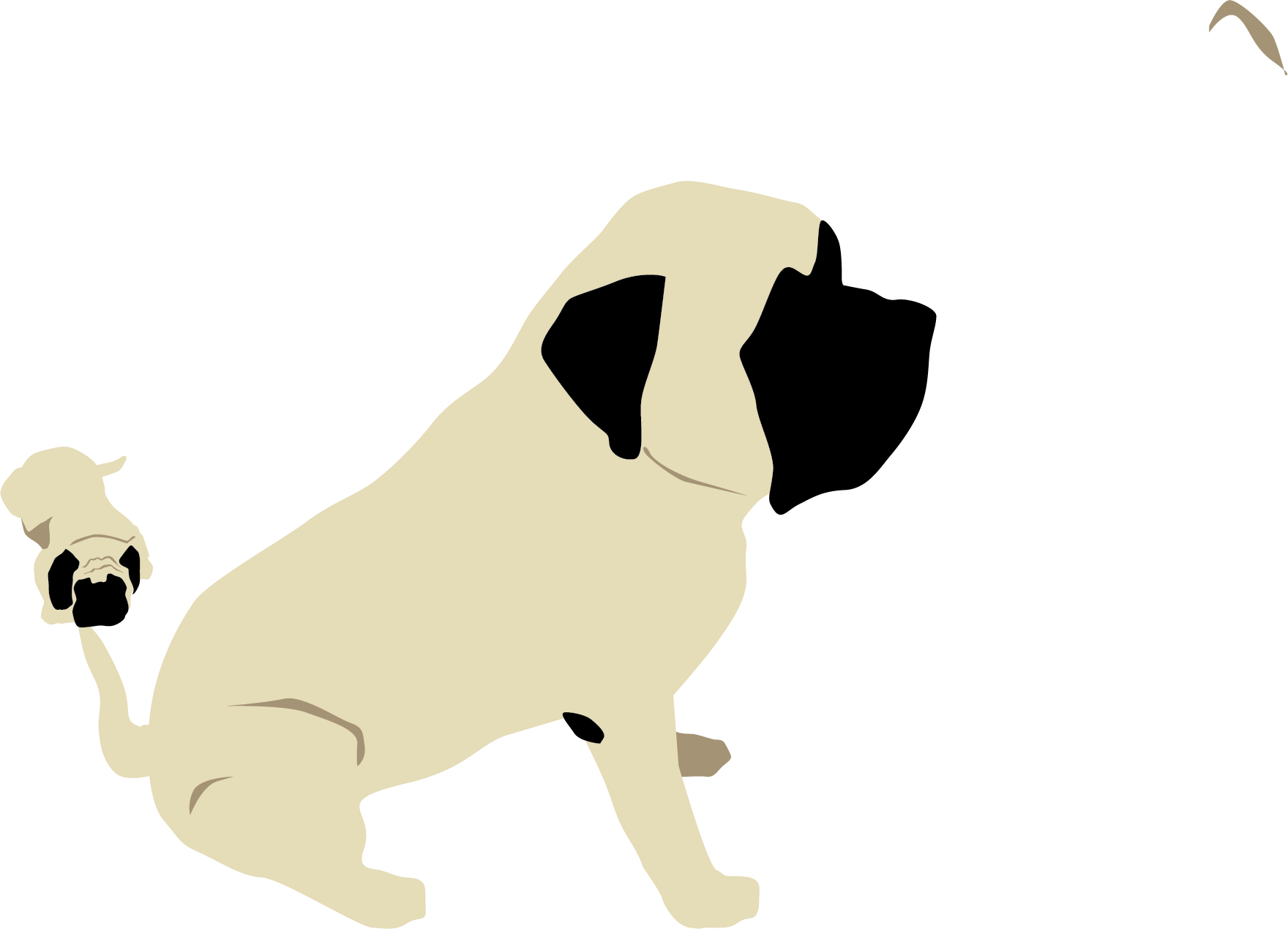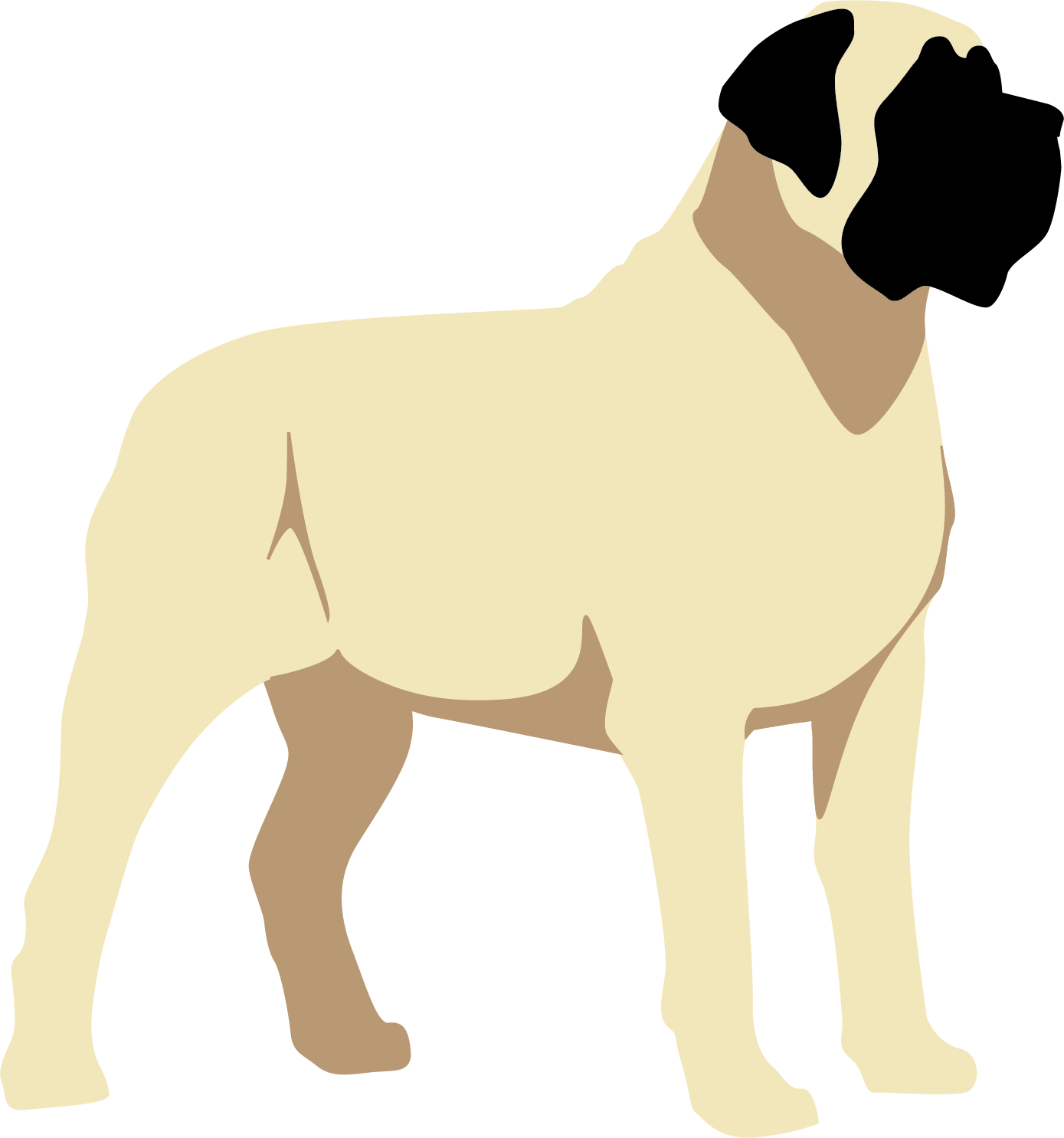Mastiff Info
Interested in owning a Mastiff or any dog?
Before making the commitment to add a dog into your family make sure your family lifestyle is compatible with owning a dog at all. If you are a busy household and really only have time for a dog on the weekend we suggest you look for a less demanding pet.
Dogs do not know what day it is and they require as much time and attention on Monday as they do on Saturday.
Realize that you are responsible for ensuring that your dog becomes a good canine citizen. you must train, socialize and keep them healthy for the good of the dog, your family and everyone around you.
We've put together some information we hope will be helpful. But there are plenty of reputable sources for information that can help you decide if a dog is right for you and what breed is the best for your lifestyle. If a puppy isn't for you consider Rescue — every breed has Rescue contacts.
The American Kennel Club (AKC) website has the standards and basic information of all the recognized breeds. Also links to the parent club of each breed and information about local events.
Mastiff Club of America is the parent club for Mastiffs. Their site includes a ton of valuable information including a Breed History and FAQ, llinks to Regional Clubs and links to Mastiff Rescue groups.
TRue Companion & Guardian
Mastiffs have been bred for over two thousand years. Originally bred as dogs of war they evolved into keepers of the castle ultimately becoming the family companions and guardians that they are today…
Living with a Mastiff
or how your Mastiff will change your life completely!
On this page we have listed just a few of ways a Mastiff will change the way you go about your daily business…
Mastiff vs American mastiff
Our dogs are Mastiffs, sometimes referred to as English Mastiffs. These are NOT american mastiffs! In our opinion the mixed breed mutt called american mastiff is an…
Choosing a dog
Are you ready? Before considering what breed is appropriate for your family be sure you are ready for any dog at all. Everyone in the family must be on board with the new addition. Never expect that children will take care of the dog. You will be making a lifelong commitment…
AKC Mastiff Standard
General Appearance: The Mastiff is a large, massive, symmetrical dog with a well-knit frame. The impression is one of grandeur and dignity. Dogs are more massive throughout. Bitches should not be faulted for being somewhat smaller in all dimensions while maintaining a proportionally powerful structure. A good evaluation considers positive qualities of type and soundness with equal weight.
Size, Proportion, Substance: Size - Dogs, minimum, 30 inches at the shoulder. Bitches, minimum, 271⁄2 inches at the shoulder. Fault - Dogs or bitches below the minimum standard. The farther below standard, the greater the fault. Proportion - Rectangular, the length of the dog from forechest to rump is somewhat longer than the height at the withers. The height of the dog should come from depth of body rather than from length of leg. Substance - Massive, heavy boned, with a powerful muscle structure. Great depth and breadth desirable. Fault - Lack of substance or slab sided.
Head: In general outline giving a massive appearance when viewed from any angle. Breadth greatly desired. Eyes set wide apart, medium in size, never too prominent. Expression alert but kindly. Color of eyes brown, the darker the better, and showing no haw. Light eyes or a predatory expression is undesirable. Ears small in proportion to the skull, V-shaped, rounded at the tips. Leather moderately thin, set widely apart at the highest points on the sides of the skull continuing the outline across the summit. They should lie close to the cheeks when in repose. Ears dark in color, the blacker the better, conforming to the color of the muzzle. Skull broad and somewhat flattened between the ears, forehead slightly curved, showing marked wrinkles which are particularly distinctive when at attention. Brows (superciliary ridges) moderately raised. Muscles of the temples well developed, those of the cheeks extremely powerful. Arch across the skull a flattened curve with a furrow up the center of the forehead. This extends from between the eyes to halfway up the skull. The stop between the eyes well marked but not too abrupt. Muzzle should be half the length of the skull, thus dividing the head into three parts-one for the foreface and two for the skull. In other words, the distance from the tip of the nose to stop is equal to one-half the distance between the stop and the occiput. Circumference of the muzzle (measured midway between the eyes and nose) to that of the head (measured before the ears) is as 3 is to 5. Muzzle short, broad under the eyes and running nearly equal in width to the end of the nose. Truncated, i.e. blunt and cut off square, thus forming a right angle with the upper line of the face. Of great depth from the point of the nose to the underjaw. Underjaw broad to the end and slightly rounded. Muzzle dark in color, the blacker the better. Fault - snipiness of the muzzle. Nose broad and always dark in color, the blacker the better, with spread flat nostrils (not pointed or turned up) in profile. Lips diverging at obtuse angles with the septum and sufficiently pendulous so as to show a modified square profile. Canine Teeth - healthy and wide apart. Jaws powerful. Scissors bite preferred, but a moderately undershot jaw should not be faulted providing the teeth are not visible when the mouth is closed.
Neck, Topline, Body: Neck powerful, very muscular, slightly arched, and of medium length. The neck gradually increases in circumference as it approaches the shoulder. Neck moderately "dry" (not showing an excess of loose skin). Topline - In profile the topline should be straight, level, and firm, not swaybacked, roached, or dropping off sharply behind the high point of the rump. Chest wide, deep, rounded, and well let down between the forelegs, extending at least to the elbow. Forechest should be deep and well defined with the breastbone extending in front of the foremost point of the shoulders. Ribs well rounded. False ribs deep and well set
back. Underline - There should be a reasonable, but not exaggerated, tuck-up. Back muscular, powerful, and straight. When viewed from the rear, there should be a slight rounding over the rump. Loins wide and muscular. Tail set on moderately high and reaching to the hocks or a little below. Wide at the root, tapering to the end, hanging straight in repose, forming a slight curve, but never over the back when the dog is in motion.
Forequarters: Shoulders moderately sloping, powerful and muscular, with no tendency to looseness. Degree of front angulation to match correct rear angulation. Legs straight, strong and set wide apart, heavy boned. Elbows parallel to body. Pasterns strong and bent only slightly. Feet large, round, and compact with well arched toes. Black nails preferred.
Hindquarters: Hindquarters broad, wide and muscular. Second thighs well developed, leading to a strong hock joint. Stifle joint is moderately angulated matching the front. Rear legs are wide apart and parallel when viewed from the rear. When the portion of the leg below the hock is correctly "set back" and stands perpendicular to the ground, a plumb line dropped from the rearmost point of the hindquarters will pass in front of the foot. This rules out straight hocks, and since stifle angulation varies with hock angulation, it also rules out insufficiently angulated stifles. Fault - Straight stifles.
Coat: Outer coat straight, coarse, and of moderately short length. Undercoat dense, short, and close lying. Coat should not be so long as to produce "fringe" on the belly, tail, or hind
legs. Fault Long or wavy coat.
Color: Fawn, apricot, or brindle. Brindle should have fawn or apricot as a background color which should be completely covered with very dark stripes. Muzzle, ears, and nose must be dark in color, the blacker the better, with similar color tone around the eye orbits and extending upward between them. A small patch of white on the chest is permitted. Faults - Excessive white on the chest or white on any other part of the body. Mask, ears, or nose lacking dark pigment.
Gait: The gait denotes power and strength. The rear legs should have drive, while the forelegs should track smoothly with good reach. In motion, the legs move straight forward; as the dog's speed increases from a walk to a trot, the feet move in toward the center line of the body to maintain balance.
Temperament: A combination of grandeur and good nature, courage and docility. Dignity, rather than gaiety, is the Mastiff's correct demeanor. Judges should not condone shyness or viciousness. Conversely, judges should also beware of putting a premium on showiness.





